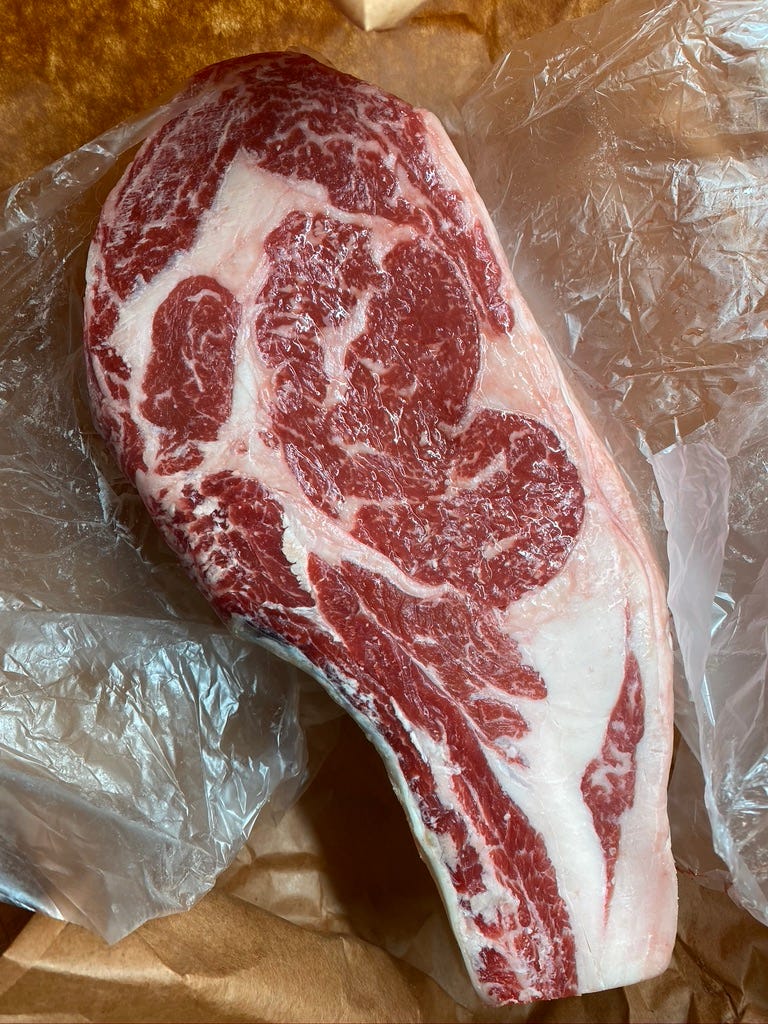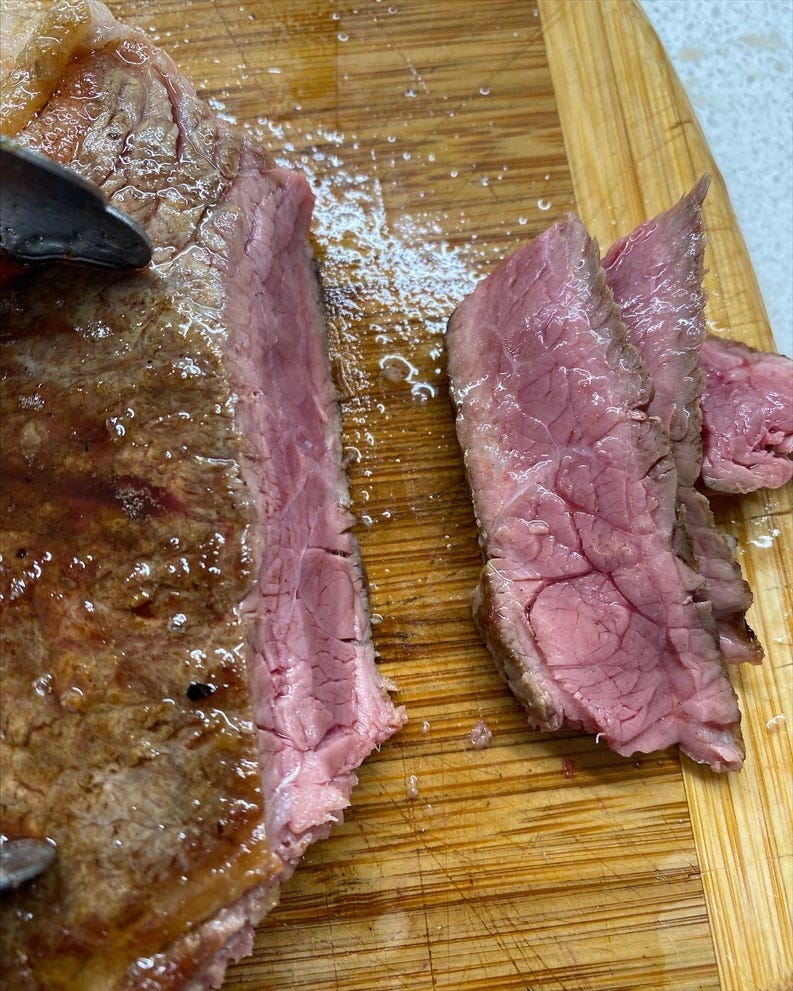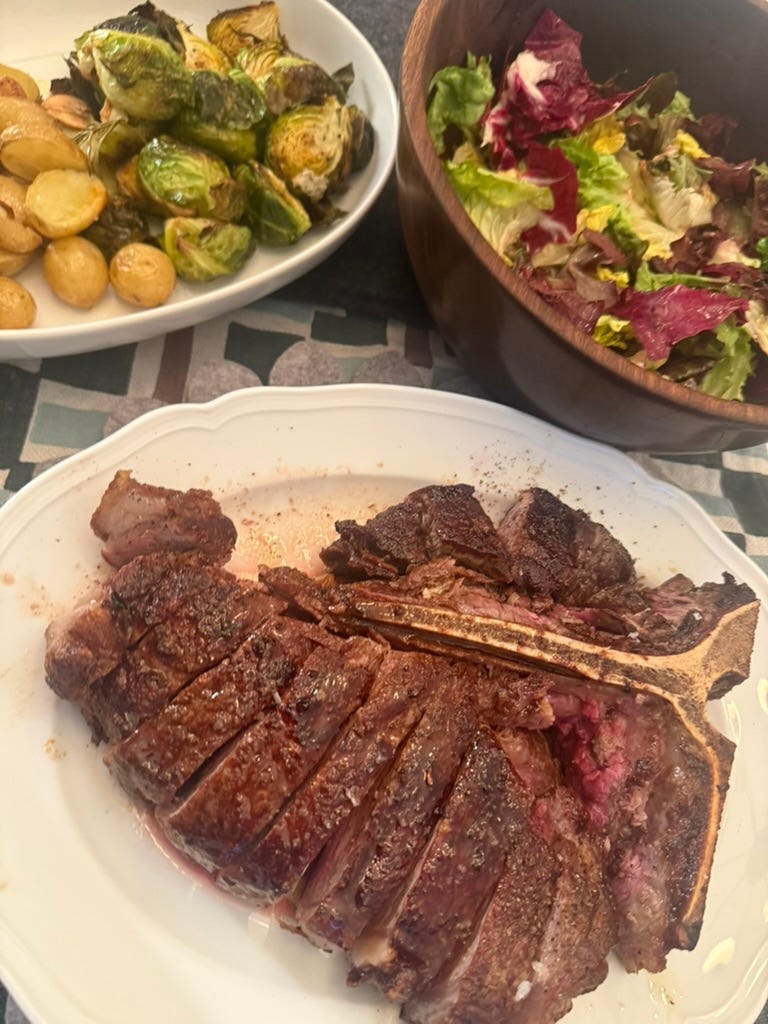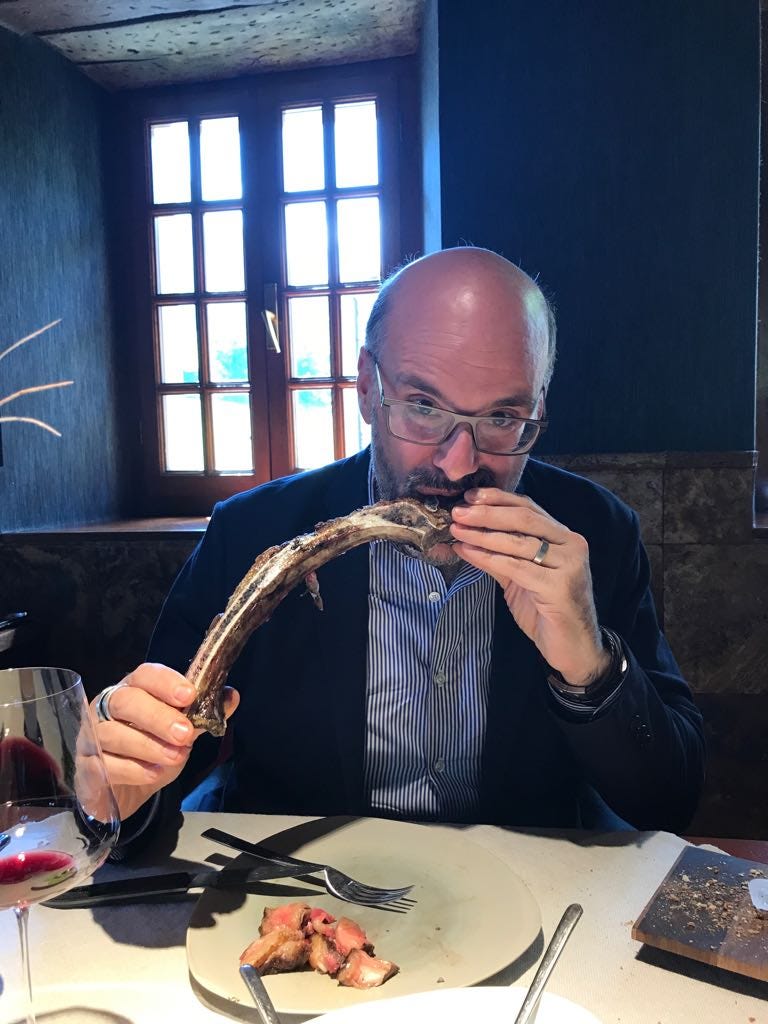Issue 201: Steaking My Ground
Meat-Eating Memories, Côte de Boeuf, Celebratory Meals, A New (to me) Technique
Content Warning: The following is not suitable for vegetarians and vegans, whom I love and respect.
Given how many steak bones I’ve watched my husband gnaw on across the table from me, it’s hard to imagine he was a vegetarian for more than a decade before we met. These days, few things make Nate happier than a slab of dry-aged beef, cooked medium-rare on the bone.

Like many North Americans of my generation, I grew up eating a lot of meat. When I think of my mother’s weekly order at the butcher shop in our north Toronto neighborhood—one I would later work in part time during high school—it’s hard to fathom the amount of animal protein my family consumed.
Until my dad died (I was nine) and my siblings started heading off to boarding school or college, there were six of us around the dinner table, often eight including friends who regularly joined. We always waited until my father was home and everyone was seated to eat. Meat was the center of every meal. Three chickens roasted side by side, a whole brisket braised until falling apart, a pile of lamb or veal chops seared crisp on the grill, flank steak broiled, sliced thin, and smothered under mushrooms and onions sautéed in butter—these were all in regular rotation.
When, at age 16, my older brother Sheldon became a vegetarian, you could sense real fear he might starve to death. It was the 1970s. The number of side dishes surrounding our meat increased significantly, just in case. We gained weight; Sheldon lost it. More than fifty years later, he’s still going strong.
A Cut Above
Rib steaks were my mother’s favorite. Her freezer was always full of them, as she’d pick up a few extras whenever they were on sale. (She always had a couple of standing rib roasts in there, too, for special occasions.) Flank steaks and NY strips were tied for second.
To cook her steaks, my mother relied on two techniques: broiling and grilling. Whichever she chose, she’d turned the heat on high, lay on the meat, salt it generously, and cook it until its juices no longer flowed. It wasn’t until years later in a graduate course on food culture that I learned about the kashrut proscription against consuming blood and realized my mother’s doneness preference might have had a religious root, certainly a cultural one. (See Catskills comedians of another era.) I’m not sure even she was aware. Never mind that flank steak is not a kosher cut and those mushrooms and onions cooked in butter are a trayf garnish, the meat had to be well done.
Although I consume a lot less meat than I used to and insist when I do that it’s been raised with care, like Nate, I, too, love a good steak. A dry-aged, extra-thick-cut rib steak on the bone—aka côte de boeuf—is one of our go-to meals for celebration.
With respect to my mom, my technique for cooking steak was forever changed by my friend Laurent Gras. Like other French chefs who’ve spent their careers orbiting the highest galaxy of Michelin stars, Laurent cooks a steak in a particular way: seared in a cast-iron pan and basted in an embarrassing amount of butter with a handful of garlic cloves sizzling away. I’ve watched him do it and enjoyed the results more times than I care to admit.
Taken to just the other side of rare, this process works quickly, producing an amazing crust, tender, juicy flesh, and a bone worth gnawing on.
Important Pointers
Although it can be applied to any cut, I think this butter-basting technique works best on a bone-in rib steak cut thick, two inches or more. A hefty porterhouse works well, too. Preheat your oven to 450°F., so you can pop in the pan to finish cooking, if necessary. Relatedly, use an oven-safe, cast-iron pan.
Take the steak out of the refrigerator at least an hour, preferably more, before you will cook it so it comes to room temperature, and salt it right away. Just before cooking, use a paper towel to pat dry the surface. Don’t skimp on the butter or garlic. Use a large, deep metal spoon to baste the steak with a generous amount of sizzling butter in every go.
Oh, and don’t overcook it. To be sure, use an instant-read thermometer and insert it in the center of the flesh near the bone. I like to bring steak to an internal temp of about 125°F. If the crust has formed, but the center is not quite done, pop it in the preheated oven for five minutes or so to finish cooking. Once the internal temperature is a few degress shy of the desired number, let the steak sit on a cutting board for five minutes or so to finish cooking and to relax before slicing. Catch any juices that are released—sorry Adonai—and pour them back over the steak before serving. Sprinkle the slices with some flaky finishing salt and a grind or two of black pepper.
A Nod, A Celebration
Every time Nate and I enjoy a delicious, juicy, rare steak, he pays homage to an aunt (by marriage), whose preference for rare meat was a familial source of disgust and the butt of jokes. She was so right, he now admits to no one in particular.
We finally sold our Manhattan apartment last week and I happened to be in the city for the closing. The morning I was coming home to New Hampshire, I had some time to kill and made either the right or the wrong decision, depending on your point of view, to wander into Eataly before making my way to the bus. I picked up a few pounds of giant white asparagus that had just arrived from Holland, a few cans of imported Italian DOP San Marzano tomatoes, and a colorful selection of chicories. Staring at me from the butcher case was a gorgeous porterhouse, an appropriate way to mark the occasion of our sale, I thought. Into my suitcase with everything else it went.
The next night we opened a bottle of big red wine. I roasted some fingerling potatoes and Brussels sprouts, tossed the chicories in a fine Tuscan olive oil and homemade vinegar, and I cooked that beautiful steak using Laurent’s buttery technique. Nate gnawed on the bone.
RECIPE: Côte de Boeuf
1 dry-aged, bone-in rib steak or porterhouse, cut about 2 inches thick (between 1 1/2 and 2 pounds)
Fine sea salt
Peanut oil, or another high-smoke-point oil
1/2 pound unsalted butter, at room temperature
6 to 8 cloves garlic, smashed but not peeled
Flaky finishing salt, such as Maldon or Falksalt
Freshly ground black pepper
At least an hour before cooking and preferably more, remove the steak from the refrigerator and unwrap it. Season it with fine sea salt and let it sit on the counter to come to room temperature.
Preheat the oven to 450°F. Turn on your hood, open the windows, start any fans, and/or do whatever you must to prevent your smoke detectors from going off.
Place a large, oven-proof, cast-iron pan over high heat. Once hot, pour in just enough oil to cover the bottom of the pan. With paper towel, pat the surface of the steak dry and set in the hot pan. Sear until nicely browned on all sides, including the edges. To get a good sear, use tongs to pick up the meat and press all sides against the hot pan, especially the fat, until browned.
Pour off the oil and any fat that has rendered in the pan. Lower the heat to medium high. Add the butter and the smashed garlic to the pan. As it melts, tilt the pan and use a large metal spoon to baste the steak repeatedly with the sizzling butter. Flip and baste the second side. You should keep going for a good five minutes or so, making sure to baste the entire surface of the meat. Check the internal temperature near the bone with an instant-read thermometer to make sure you don’t overcook it. I stop at 125°F. for rare, go to 130°F. for medium. If a nice, dark crust has formed but the steak is not quite done, you can keep basting on top of the stove or set the pan in the preheated oven for a few minutes.
Check the temperature. If done, remove from the oven or take off the stove. Baste a few more times for good measure. Remove the steak to a plate or cutting board and let sit for five minutes. Cut the meat around and off the bone and then slice the meat against the grain. Arrange on a serving platter. Pour any juices that have accumulated on the cutting board on top. Sprinkle with flaky salt and a few grinds of black pepper and serve.







